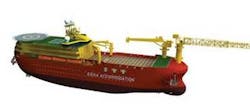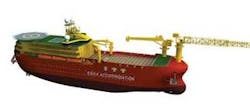Accommodation monohull aims at improved uptime, transit speeds
Against the backdrop of a serious shortfall in the supply of offshore accommodation support services, Edda Accommodation is preparing to enter the sector with the world’s first purpose-built monohull accommodation vessel. In June the company placed an order for the NOK 850 million ($148.5 million) unit with Spanish yard Astillero Barreras. Delivery is scheduled for late 2009.
Demand in the buoyant offshore market has led to some monohulls being deployed for accommodation. This is how Edda Accommodation, a subsidiary of Østensjø Group which operates platform supply vessels and tugs, came into being.
In 2004, Østensjø convertedEdda Fjord, a multipurpose PSV, to provide quarters for 330 personnel working on the offshore hookup and commissioning of Shell’s Bonga FPSO off Nigeria. Afterwards the vessel moved to the Gulf of Mexico to provide accommodation for 450 people working on BP’s Thunder Horse production platform. Both are deepwater locations.
“Both jobs worked out very well,” says Johan Rokstad, managing director of Edda Accommodation. “AtBonga, the vessel proved its ability to sit in dynamic positioning mode connected to the FPSO by a gangway. During 11 months, it disconnected for a total of only 10.5 hours due to weather reasons.”
Aging fleet
Additional accommodation capacity is needed not only to support new installations but also to house personnel working to increase the capacity of platforms or to extend their operational lifetime. The semisubmersible units which form the bulk of the global accommodation fleet are aging.
Edda’s new vessel will be built to a design from the Norwegian ship design house Vik-Sandvik. It will be classed by DNV as an offshore vessel rather than as a mobile offshore unit. Edda has invested time to ensure that the vessel can operate for several years without any need for drydocking or major repairs.
Though a monohull, the Edda unit will have motions more like those of a barge or semi. It will connect to the host installation through a heave-compensated hydraulic telescopic gangway, with design criteria enabling operations in 5 m (16 ft) significant wave height. According to Rokstad, it will achieve 92% uptime over a 12-month period in the North Sea. In more benign regions it should be able to stay connected permanently except in the event of a hurricane.
The vessel will be built to Norwegian and UK requirements but the aim, at least initially, is to promote it in the regions up to 30° north and south of the equator - which include West Africa, Brazil, the Gulf of Mexico, the Far East, and Australia.
The monohull concept provides advantages over the semi, Rokstad claims. Mobilization and demobilization costs are lower. The monohull should move from one location to another under its own steam. A semi needs a tug to tow it and an anchor-handling vessel or two to moor and unmoor it. The Edda Accommodation vessel will have a sailing speed of 12 knots, faster than a towed semi.
It will be able to moor conventionally with a four-point system, but will also be equipped with a DP-3 dynamic positioning system which will enable it to work in deepwater.
Five thrusters for the system have been ordered from Voith Schneider. In addition to providing accurate and stable station-keeping, this system should deliver low fuel consumption during both DP operations and when steaming, Rokstad says.
The company cannot quantify the savings will be compared with a conventional propulsion system, but should have an idea this summer when it brings a newbuild PSV equipped with Voith Schneider propulsion into operation for Shell in the UK sector.
The company has placed an order for the marine engines - six AC generators, each of 2,925 KW - with Wärtsilä. Accommodation capacity will be 600, with a mixture of one-, two-, and four-bed cabins, or 300 in single cabins. If supporting an onshore project, the numbers could be increased to as many as 1,000.
The unit will have craneage capacity in the shape of a heave-compensated knuckle-boom crane and two marine deck cranes, the size and reach of which have yet to be decided. Getting the parameters for the knuckle-boom crane right is particularly important as it will be responsible for lifting loads onto the host platform, says Rokstad. The crane will have a height of up to 55 m (180 ft) under the hook and a fairly long boom.
A telescopic gangway will be in the vessel’s bow, along with the knuckle-boom crane. The two deck cranes will be midships, one on either side. The accommodation will occupy the rear half of the ship, and the bridge will be midships.
The vessel will be 130 m (426.5 ft) long and 27 m (88.5 ft) broad, with an available deck area of 1,400 sq m (15,069 sq ft), including 260 sq m (2,799 sq ft) of covered workshop area. Østensjø will itself finance the major part of the newbuilding project. In view of the positive response from potential customers, the company already is preparing plans for a second unit, Rokstad says.

